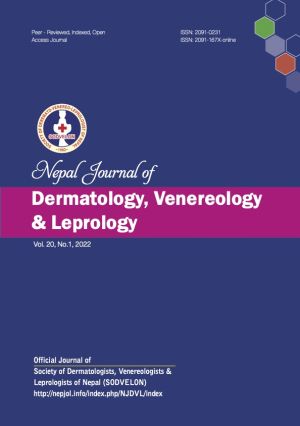A Case of Dirty Dermatosis (Dermatitis Neglecta)
DOI:
https://doi.org/10.3126/njdvl.v20i1.36889Keywords:
Dermatitis neglecta, Isopropyl alcohol, Scrotum pathology, Skin careAbstract
Dermatitis Neglecta, also known dermatosis neglecta refers to a dermatological condition that occurs from lack of hygiene. It is a condition that results from insufficient frictional cleansing leading to accumulation of corneocytes sebum and sweat eventually resulting in hyperpigmented patch or verrucous plaque. Regular bathing is very important for keeping the skin clean. Bathing and scrubbing the skin helps to remove germs, oils, and dead skin cells. Lack of bathing for a long time can also cause Dermatitis Neglecta. We are presenting a case of 22 years old boy who had itching in the scrotum for 4 years and he was being treated for scabies and tinea cruris by various practitioners. On observation we found it to be covered with dark coloured raised lesions, after we rubbed it with cotton and spirit, we found it to be Dermatitis Neglecta of scrotum. Terra firma forme dermatosis is differentiated from it by presence of sufficient hygiene, absence of corn flake-like brownish scales and successful annihilation of pigmentation with isopropyl alcohol in the former and effective clearance of lesions with soap and water in the latter. However, isopropyl alcohol is operative in both disorders.
Downloads
Downloads
Published
How to Cite
Issue
Section
License
Copyright (c) 2022 Society of Dermatologists, Venereologists and Leprologists of Nepal

This work is licensed under a Creative Commons Attribution 4.0 International License.
Copyright on any research article is transferred in full to Nepal Journal of Dermatology, Venereology & Leprology upon publication. The copyright transfer includes the right to reproduce and distribute the article in any form of reproduction (printing, electronic media or any other form).




